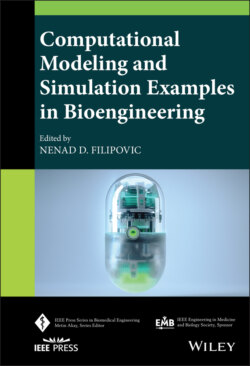Читать книгу Computational Modeling and Simulation Examples in Bioengineering - Группа авторов - Страница 14
1.1 Background
ОглавлениеAbdominal aortic aneurysm (AAA) is a dilation of the aorta beyond 50% of the normal vessel diameter [1] that is frequently observed in the aging population [2] and it affects 6–9% of the people in the industrialized world. It is a major health problem that typically affects men after the age of 50 [3] and it is the thirteenth leading cause of death in Western societies [4]. AAAs cause about 15 000 deaths per year in the United States only [5], and 1.3% of all deaths among men aged 65–85 years in developed countries [6–8]. In the United States alone, 1.5 million have undiagnosed AAAs [3]. They can remain asymptomatic for most of their development and, if left untreated, they can enlarge and eventually rupture with catastrophic mortality rate of 80% [9] to 90% [2]. On the other hand, the mortality following elective AAA repair has significantly improved to 3–6% [10] which clearly demonstrates the need of diagnosing and monitoring AAAs on time in order to make progress in both medical and economic domain.
A myriad of different factors are established in the literature to account for AAA formation, expansion, and, eventually, rupture. Namely, a substantial amount of research on AAA expansion and rupture focuses on different biological and biomechanical factors and, lately, special attention is put to genes and chemical influences. Among biological factors and risk factors, authors usually discuss the influence of diameter, sex, blood pressure, chronic obstructive pulmonary disease, and smoking [11]. From a biomechanical point of view, major factors contributing to AAA expansion and rupture are the wall stress [12, 13] and strength [14], wall stiffness [15], vessel asymmetry [16–19], intraluminal thrombus (ILT) [20, 21], entire geometry [22, 23], etc. Namely, according to the biomechanical perspective, AAA rupture is usually defined as a material failure of the degenerated AAA wall to withstand the stress exerted on it [24]. However, the relationship between rupture and biomechanics of aorta proved to be more complex [10] and the evaluation based only on one of these parameters is not sufficient.
For many years, diameter was taken to be the primary parameter associated with rupture risk estimation. Namely, the threshold of ≥5.5 cm3 was applied as indicative for AAA repair [10]. However, continuous studies in the past showed that while 10–24% of small aneurysms (<5.5 cm) may rupture [1], aneurisms which diameter exceeds the threshold remain stable. These findings cast doubt over the suitability of surgical repair based solely on the maximum diameter criterion [16–18]. In order to refute “diameter criterion” rule, many other criteria and parameters ensued. In contrast, the survey conducted in 2006 [25] confirmed that 92% of surgeons still use maximum diameter criterion and growth rate in making decisions about the surgical intervention while 19% of them stated that they were not even aware that biomechanics may influence the rupture risk. The results of the survey suggest that cooperation of surgeons and engineers is necessary in order not just to make technical advances but to implement them in practice.
Mutual collaboration of clinicians and engineers resulted in different efforts and methodologies proposed in the last few decades, all striving to make progress in the domain of AAA expansion and rupture prediction. This paper reviews some of the most significant studies in the area of AAA modeling in the past decades which further understanding of utmost importance for making additional progress toward validation and application in the clinical setting. We firstly described computational methods applied for AAA in chronological order. Then, different experimental testing as well as our own testing is described in order to determine the mechanical properties of AAA. Mechanical–chemical including ILT modeling is separately analyzed. Finite element procedure including fluid–structure interaction (FSI) from our group is described. In the end, some of data mining (DM) approach and vision for future clinical decision support system (DSS) is given.
